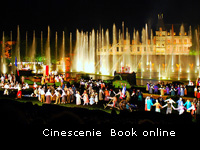Tourist Information, Vendee History, Accommodation, Photos, Reviews, Maps,
Wars of the Vendée 1793-96
Before
starting on the details of the wars of the Vendée here are a few facts
that may influence your understanding of this traumatic period of the
History of the Vendée. The Vendée only came into existence after the
Revolution; it was officially declared on February 28th 1790 and took
over much, but not all of the former Bas Poitou. The wars that followed
were in essence those of that region, it started outside of what is now
the Vendée. The Vendéen’s originally embraced the revolution in the hope
that a better life would follow. It was only with the introduction of
jurist priests (those that swore allegiance to the revolution) that
disquiet started and one would need to ask if the simple farmers which
made up the vast majority of the population were not conduced by the
priest who saw their livelihood being taken away. Even with this
disquiet it was not until compulsory conscription to fight in the new
Revolutionary army was imposed, that all out hostilities broke out. It
is also interesting to note that even today the French Government
refuses to acknowledge the war, and the history of the war is not taught
in the country’s general curriculum. It is only taught in the schools
of the Vendée and the surrounding departments that were involved, even
though 300,000 Vendéens and possibly even more government troops were
killed. The story therefore tends to be told from one side’s point of
view, The towns of Les Sables d'Olonne and Luçon refused to join the
revolt and stayed staunchly revolutionary. Carl Marx in his writings
uses the word Vendéen to mean counter revolutionary and in essence that
is what the war of the Vendée was. The Vendée was Staunchly Royalist,
this being where Richard the Lion Heart had his main castle at Talmont
St.Hilaire. Richard's Mother Eleanor of Aquitaine was born at
Nieul-sur-l'Autise just outside of Fontenay le Comte in the South of the
Vendée. This is Plantagenet country, and during the Revolution the
Vendéens found themselves on the losing side.
Napoleon called it “This War of Giants", it involved 21 major battles and more than 700 lesser engagements.
When the Memorial de la Vendee was open on the 25th September 1993 the address was given by Alexander Solzhenitsyn. His take on these events in can be read here
Background
Differences in class were not as great in the Vendée as in the other
French provinces, or Paris. In rural Vendée, the local nobility seem to
have been more residential and less resented than in other parts of
France. In this particularly isolated part of France the conflict that
drove the revolution was lessened by strong adherence of the populace to
the Catholic Church. There were outbreaks of anti-Republican violence
in 1791 and 1793. It was not until the social unrest combined the Civil
Constitution of the Clergy (1790) and the Conscription (or "Levy")
Decree (1793) that the region truly erupted. The Civil Constitution
required all clerics to swear allegiance to the Republic and to the
anti-clerical National Constituent Assembly. The Vendéen clergy almost
to a man refused to swear the oath and were replaced by the
Revolutionary authorities with ”Jurors”, who were disliked and condemned
as intruders. Nonjuring priests declared the new civic ceremonies
worthless, and in response gangs of Republicans came from the cities
into the countryside, closing and vandalizing the churches of nonjuring
priests.
Outbreak of revolt
Vendéen peasants initially supported the revolution, but they
rebelled against the injustices of the Republic on March 7th, 1793. In
the Vendée there were few troops to control them, whereas the more
serious riots that occurred in Brittany were quickly broken. There were
spontaneous (and) riots on March 10-13 in many of the towns and
villages. The representatives of the Republic were singled out for
attack and murder. In the bloodiest outburst, in Machecoul on March 11,
forty men were beaten and stabbed to death on the streets, and another
four hundred were gathered up and arrested. The men were taken out in
'rosaries' (tied in a line with rope around the chest), made to dig
ditches and shot. Their bodies then tumbled into the grave that they had
dug. The crowds moved from the smaller to the larger settlements,
Cholet in the north and Fontenay-le Comte in the south fell to the
rebels. Local Nobles were approached, d’Elbee, Sapinaud de Verrie and
Charett became the leaders of their local force. The clergy were also
fairly active in rallying the people. The main force of the rebels
operated on a small scale, using guerrilla tactics supported by the
insurgents' local knowledge and the good-will of the people.
Republican response
The Republic responded quickly, sending (in March) over 45,000
troops into the area. The “Bleu’s” were young, badly trained and
equipped with low morale and were dispersed in small groups throughout
the region, limiting control to a few urban centres, and providing many
weak garrisons as targets. The first battle was on the night of March 19th.
A Republican army of 2,000, under General de Marcé, moving from La
Rochelle to Nantes was intercepted north of Chantonay at Pont-Charrault
near the Lay. After six hours of fighting rebel reinforcements arrived
and routed the Republican forces. The rebels advanced as far south as
Niort. On March 22nd, and another Republican force was routed near
Chalonnes in the north leaving their equipment for the grateful
Vendéans. The Vendéen Army covered the area between the Loire and the
Lay, part of Maine-et-Loire west of the Layon, and the portion of Deux
Sèvres west of the Thouet. Successes continued for some time, and
Thouars was taken in early May and Saumur in June, but the Vendéens then
turned to a protracted and wasteful siege of Nantes.
Defeat
On 1st August the Committee for public safety ordered
General Jean-Baptiste Carrier to perform a ruthless pacification. The
Republican army was reinforced, and the Vendéen army had its first
serious defeat at Cholet on October 17th and the army was
split. In October 1793 the main force, commanded by Henri de la
Rochejaquelein and numbering some 25,000 crossed the Loire, headed for
the port of Granville where they expected a British fleet and an army of
exiled French nobles. Granville was surrounded by Republican forces,
but with no British ships in sight they failed to take the city. During
the retreat they fell prey to Republican forces, and suffering from
hunger and disease they died in their thousands. The final battle at
Savenay on December 23rd was decisive. Claims of genocide
were levelled at the revolutionary forces as the government in Paris
enacted stern measures. The Reign of Terror seen elsewhere in France,
was extraordinarily brutal in the Vendée. Following the Law of 14
Frimaire, in December alone over 6,000 prisoners were executed, a number
in what was called the "national bath" were tied in groups loaded onto
barges which were then sunk in the Loire. Among them were 400 children
whom Carrier hated especially, seeing in them "brigands to be”. From
February 1794 the Republican forces launched their final "pacification"
(the Vendée-Vengé or "Vendée Avenged"), twelve columns, the colonnes infernales
("infernal columns") under Turreau were marched through the Vendée,
indiscriminately targeting not only the remaining rebels and the people
who had given them support, but the innocent as well. Beyond this
massacre there were formal orders for forced evacuation and 'scorched
earth' where farms were destroyed, crops and forests burned and villages
razed. There were many reported atrocities and a campaign of mass
killing universally targeted (at) residents of the Vendée regardless of
their combatant status, political affiliation, age or gender.
Extracts from the committee read: "The committee has prepared
measures that intend to exterminate this rebellious race of Vendéens, to
make their abodes disappear, to torch their forests, to cut their
crops”
The orders to Turreau were: "Exterminate the brigands to the
last man instead of burning the farms, punish the fleeing ones and the
cowards, and crush that horrible Vendée. Combine the most assured means
to exterminate all of this race of brigands”. The campaign dragged
to an end in March 1796. Historians have since estimated the dead to
number between 117,000 and 500,000, out of a population of around
800,000, while others have disputed the figures.
A solution was hammered out in the end whereby the Vendéens would stop
fighting and pay their taxes and in exchange the churches were allowed
to reopen. Napoleon who admired the Vendéens’ stance was later, to take
the seat of power away from Fontenay le Comte which had been the capital
of the Bas Poitou region and move it to a small village of just a few
houses called "Le Roche sur Yon" so that the region could be better
controlled from a central location, hence was created the first Napoleon
town built on a grid system now copied in so many towns and cities in
America. The Emblem of the Vendée is the two inter-linked hearts with a
cross on top, symbolizing the twin love of their country and of the
church.
When I first came to live in the Vendée 19 years ago there was still a
strong hatred of Parisiennes to the extent that if one was to move into a
house in the area he could expect to be burgled in the first week, it
was a matter of duty, but with the recent explosion in population this
seems now after more than two hundred years to be dying out .
Sites on the Wars de la Vendee
Return to find more articles on the Vendée
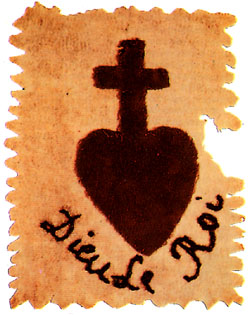
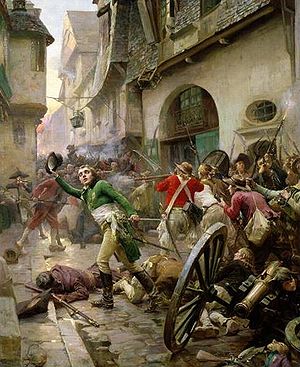
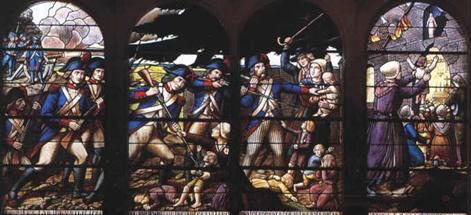

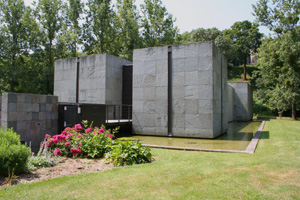
In
accordance with the law "and Freedoms" of January 6, 1978, you have the
right to access and rectify information concerning you. If you wish to
exercise this right, please contact us.
©
Copyright Vendee-Guide.co.uk 2009-12
This Website is built with Bluevoda from Vodahost














